Tinapa, a smoked fish delicacy, holds a distinguished place in Philippine cuisine, with the province of Bataan particularly renowned for its exceptional preparation. This coastal region, strategically positioned along Manila Bay, has developed a sophisticated smoking technique that has become integral to the local culinary heritage. The province's numerous artisanal smokehouses have perfected the delicate balance of brining and smoking that creates tinapa's distinctive character.
This recipe presents a refined method for creating restaurant-quality tinapa at home, adapting traditional Bataan smoking techniques for modern kitchen equipment. The process maintains the authentic elements that distinguish premium tinapa: precise brining ratios, controlled smoking temperatures, and careful attention to timing. While traditionally prepared using local mackerel or milkfish, this method can be adapted for various fish species while preserving the essential characteristics that make Bataan's tinapa a sought-after delicacy throughout the Philippines.
Jump to:
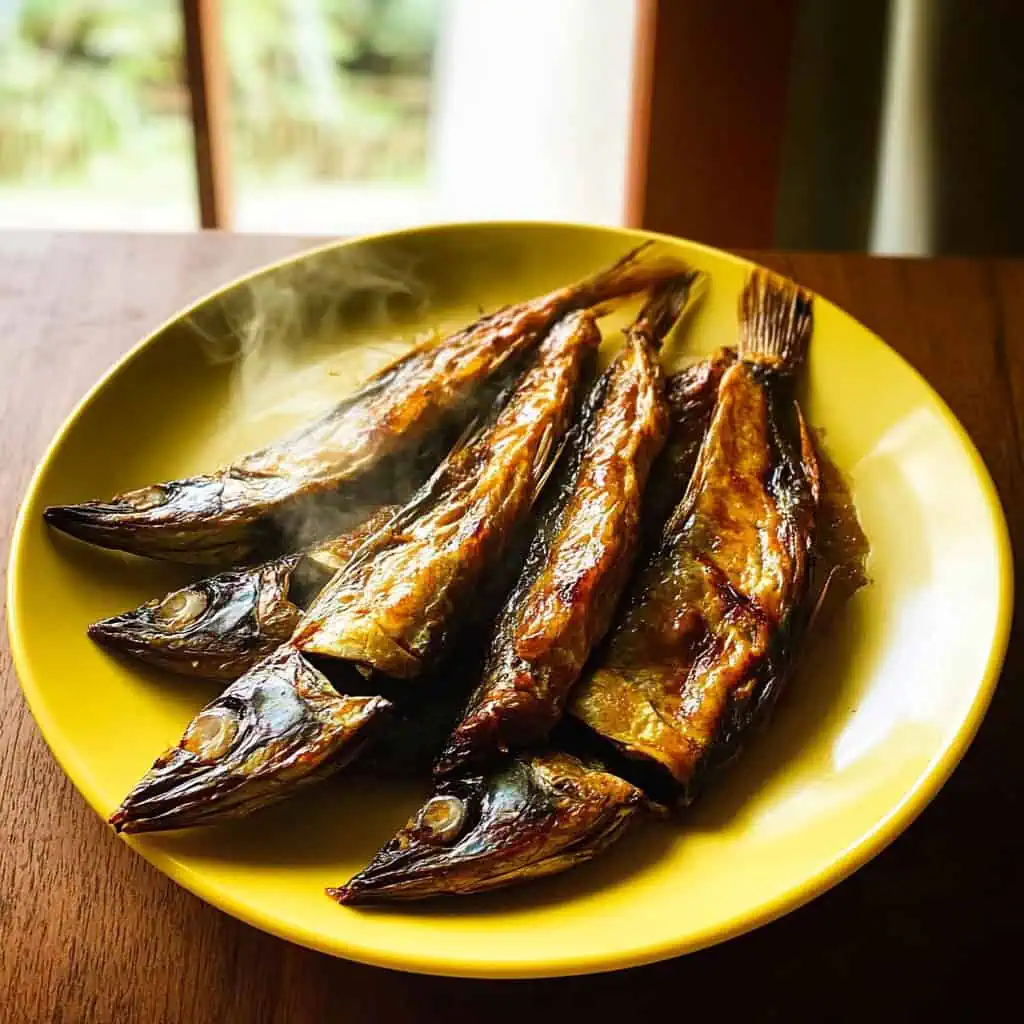
Why You'll Love This Recipe
- Authentic Filipino flavors you can't find in regular stores outside the Philippines
- Simple brine ingredients you can easily find
- Detailed smoking process for perfectly cooked fish every time
- Cheaper than buying imported tinapa
- Can be made in large batches for future meals
- Creates that distinctive smoky aroma that brings back memories of Philippine markets
Ingredients
This perfectly balanced blend creates authentic tinapa flavor through simple but powerful components. Mackerel provides the ideal fatty base to absorb smoke, while sea salt preserves and seasons.
Brown sugar balances saltiness and helps create the signature golden-brown exterior. Garlic and black pepper add depth, vinegar tenderizes the fish, and the wood chips deliver that unmistakable smoky aroma that defines traditional Filipino tinapa.
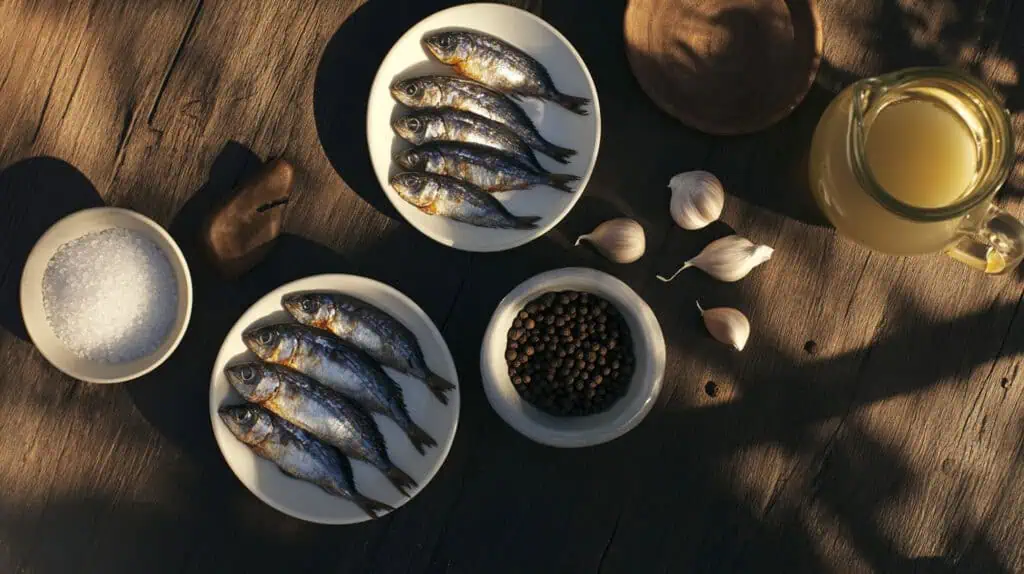
- 1 kg mackerel (hasa-hasa)
- 3 cups water
- ¾ cup sea salt
- ¼ cup brown sugar
- 1 whole garlic bulb, minced
- 1 tablespoon freshly ground black pepper
- 1 tablespoon vinegar
- 3 handfuls water-soaked wood chips
Equipment
- Gas barbecue grill - The primary cooking apparatus for smoking the fish, providing controlled heat and ventilation
- Large bowl - Used for brining the fish, should be large enough to fully submerge all fish pieces
- Roasting pan - Holds the wood chips during the smoking process
- Roasting rack - Elevates the fish above the wood chips to allow proper smoke circulation
- Aluminum foil - Lines the rack to prevent sticking and ease cleanup
- Paper towels - For patting fish dry before and after brining
- Kitchen thermometer (optional) - Helps monitor and maintain consistent smoking temperature
- Airtight containers - For storing leftover tinapa
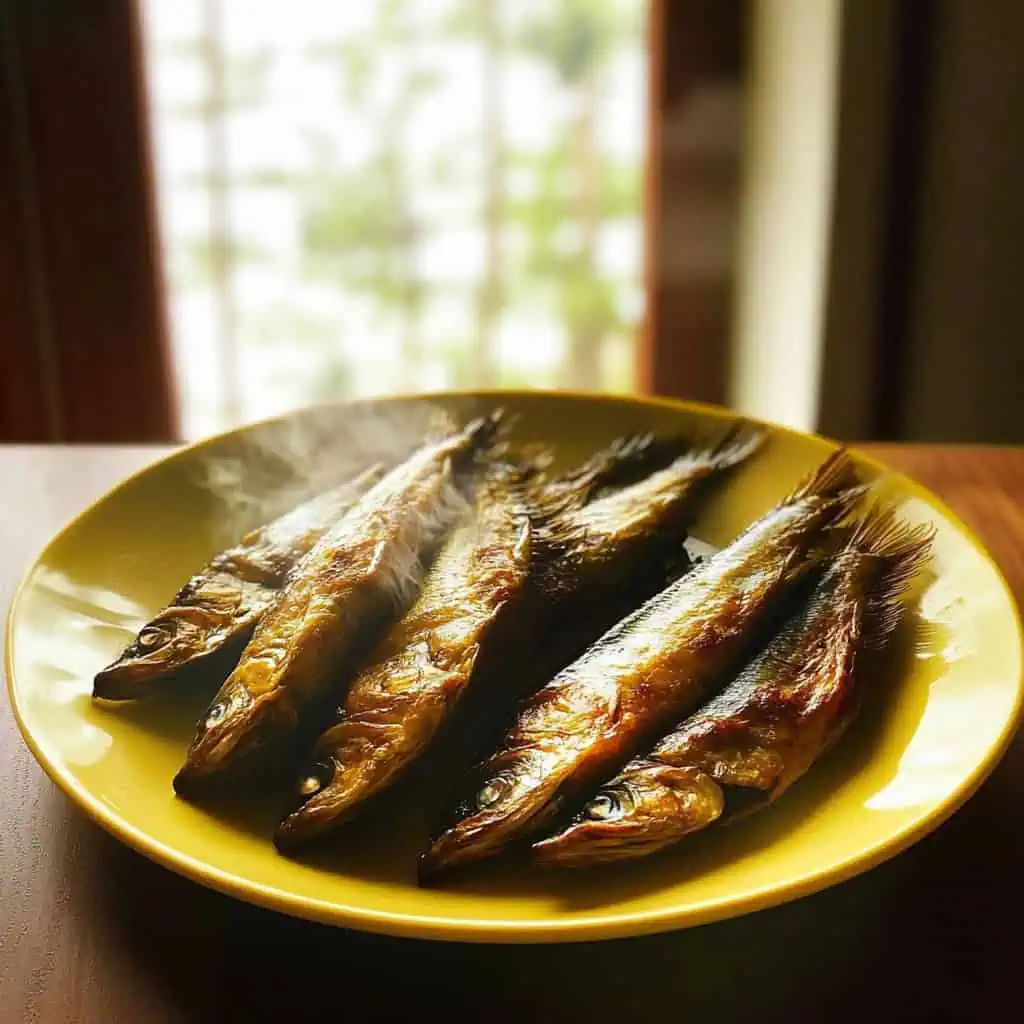
How To Make
- Start by cleaning your mackerel thoroughly. Remove all scales and guts, then rinse well under cold running water. Pat the fish dry with paper towels and set aside.
- Prepare your brine in a large bowl. Combine 3 cups water, ¾ cup sea salt, ¼ cup brown sugar, minced garlic (one whole bulb), 1 tablespoon black pepper, and 1 tablespoon vinegar. Stir until salt and sugar have completely dissolved.
- Place the cleaned fish in the brine mixture, ensuring all pieces are fully submerged. Cover the bowl and refrigerate for 6 hours at 4°C/39°F.
- While waiting, soak your wood chips in water until they're fully saturated (at least 30 minutes).
- After 6 hours, remove fish from brine and pat thoroughly dry with paper towels. Let the fish air dry on a rack for one hour at room temperature to form a pellicle (sticky surface layer that helps smoke adhere).
- Place your soaked wood chips in a roasting pan and put it on your barbecue grill. Turn the grill on to medium-high heat (175-190°C/350-375°F) and wait until you see smoke developing.
- Line a roasting rack with foil and place it above the pan of wood chips. Arrange your fish pieces on the rack, leaving space between each piece for smoke circulation.
- Lower the heat to medium (150°C/300°F) and cover the grill. Let the fish smoke until you no longer see smoke coming from the grill, approximately 45-60 minutes.
- Once the smoking stops, keep the grill covered for 10 more minutes to finish cooking through residual heat.
- Your tinapa should now be golden-brown and firm to touch. Remove from grill and let cool slightly before serving.
- For best results, serve hot with garlic fried rice (sinangag) and eggs for a traditional Filipino breakfast.

Tips from Lola's Kitchen
- Choose the freshest fish possible - Look for clear eyes, bright red gills, and firm flesh that springs back when pressed
- Brine timing is crucial - Don't reduce brining time below 4 hours or the flavors won't fully penetrate
- Pat the fish very dry before smoking to ensure proper smoke absorption and prevent steaming
- Temperature control is essential - Too hot will cook the fish too quickly without proper smoke flavor; too cool won't cook it thoroughly
- Use the right amount of wood chips - Too few won't impart enough flavor; too many can make the fish bitter
- Let the fish develop a pellicle during the air-drying stage for better smoke adhesion
- Look for the golden-brown color and firm texture to know when your tinapa is perfectly done
- The thicker the fish, the longer the smoking time - Adjust accordingly if using larger fish
- Don't rush the process - Good tinapa requires patience at every stage
Substitutions
- Fish options: While mackerel (hasa-hasa) is traditional, you can also use bangus (milkfish), galunggong (scad), salmon, or trevally. Adjust smoking time based on thickness.
- Wood chips: Traditional Filipino smoking uses local hardwoods, but you can substitute with applewood (mild and sweet), hickory (stronger smoke flavor), or even tea leaves for a more delicate smoke.
- Sea salt: Kosher salt can be used instead (reduce quantity by about 25% as it's less dense).
- Brown sugar: Muscovado gives a deeper molasses flavor, while white sugar works in a pinch but provides less depth.
- Fresh garlic: Substitute with 1 tablespoon garlic powder if fresh is unavailable.
- Vinegar: Rice vinegar, white vinegar, or even calamansi juice can be used as alternatives.
Troubleshooting
- Fish tastes too salty: Reduce brining time to 4-5 hours or decrease salt quantity in the brine by 25%.
- Not smoky enough: Add more wood chips, extend smoking time, or use stronger flavored woods like hickory.
- Fish turns out too dry: Reduce smoking time, increase brining moisture by adding ¼ cup more water to brine, or use a fattier fish.
- Skin sticking to foil: Lightly oil the foil before placing fish or use a non-stick spray.
- Fish cooking unevenly: Ensure pieces are similar in size and thickness, rotate the rack halfway through smoking.
- Fish falling apart: Your fish may be overcooked or the brining time may be too long, weakening the flesh structure.
- White residue on fish: This is protein that has risen to the surface; gently rinse before smoking or wipe with a damp cloth.
Storage & Reheating
- Refrigeration: Store in an airtight container for up to 5 days.
- Freezer storage: Wrap individual pieces tightly in plastic wrap, then aluminum foil, and freeze for up to 3 months.
- Thawing: Thaw frozen tinapa overnight in the refrigerator for best texture.
- Reheating methods:
- Steaming: 5 minutes in a steamer basket (best for preserving moisture)
- Pan-frying: 2-3 minutes per side over medium heat (creates crispy exterior)
- Oven: 10 minutes at 150°C/300°F wrapped in foil (good for larger quantities)
- Microwave: 30-45 seconds on medium power (quickest but least ideal for texture)
- Room temperature safety: Consume within 4 hours if left at room temperature.
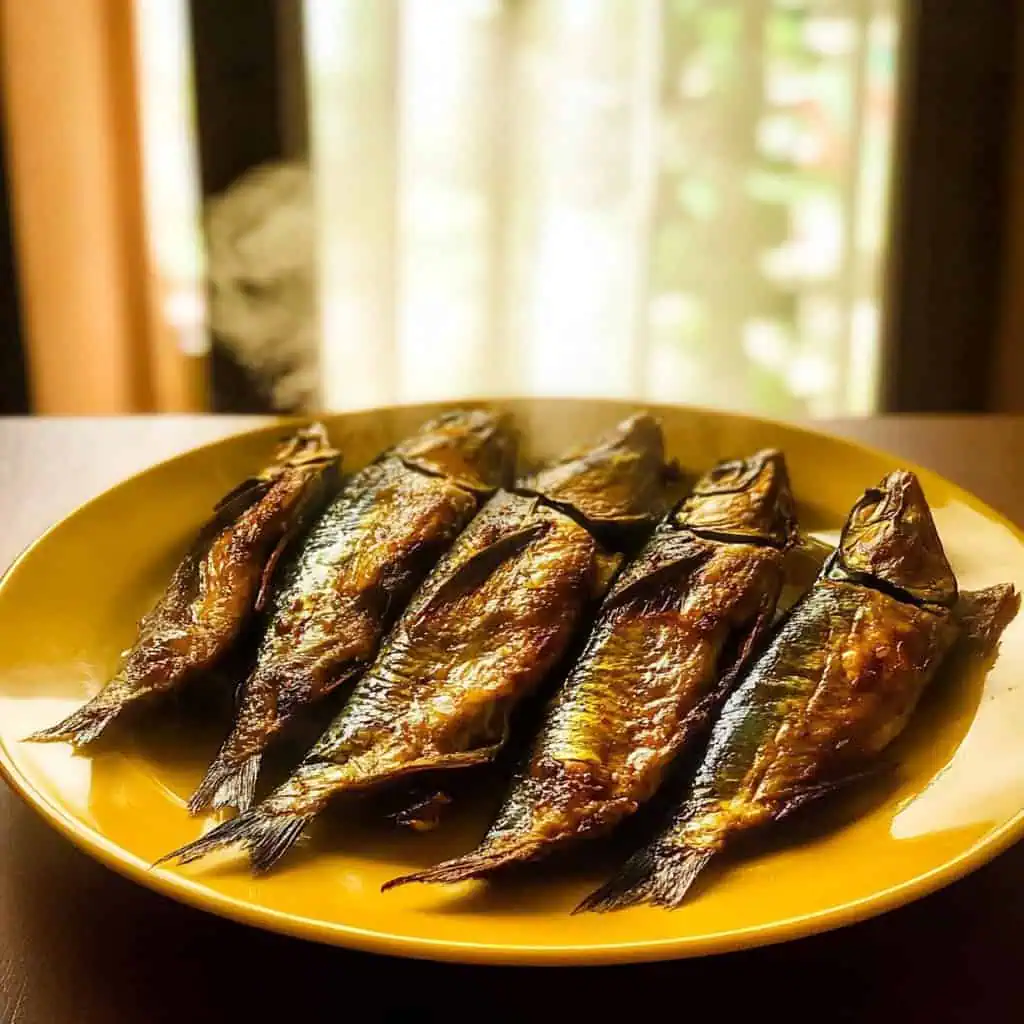
FAQ
Can I use an electric smoker instead of a grill?
Yes, electric smokers work well. Maintain temperature at 150°C (300°F) and follow the same timing guidelines. Some electric smokers may produce a milder smoke flavor.
How do I know if the fish is properly smoked?
The tinapa should be golden-brown in color, firm to touch, and flake easily when pressed with a fork. The internal temperature should reach at least 63°C (145°F).
Can I smoke other types of fish using this method?
Yes, this method works for various fish species. Adjust smoking time based on the thickness and fat content of the fish. Fattier fish like salmon may need longer smoking times.
Why do I need to soak wood chips before smoking?
Soaking prevents the wood chips from burning too quickly and ensures steady smoke production throughout the cooking process. Dry chips would ignite and burn away quickly.
Is tinapa fully cooked or is it like gravlax?
Unlike gravlax which is cured but raw, tinapa is fully cooked through the smoking process. The internal temperature reaches sufficient levels to cook the fish completely.
How can I reduce the saltiness if my first batch is too salty?
If your finished tinapa is too salty, you can soak the pieces in cold water for 15-30 minutes before cooking or serving to draw out some of the salt.
Can I use this tinapa in other recipes?
Absolutely! Flaked tinapa works wonderfully in fried rice, pasta dishes, omelettes, savory pastries, and dips. It's a versatile ingredient in Filipino cuisine.
What if I don't have a grill or smoker?
You can improvise with a wok or deep pan. Place soaked wood chips in the bottom, put a rack above, and cover the entire setup with aluminum foil. Poke small holes in the foil for ventilation and place on low heat on your stovetop. Ensure good kitchen ventilation.
Related
Looking for other recipes like this? Try these:
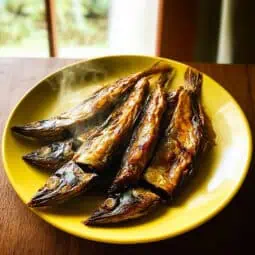
Homemade Tinapa (Filipino Smoked Fish)
Equipment
- Gas barbecue grill (Panggrill / Ihawan) For smoking the fish
- Large Bowl (Malaking Mangkok) For brining
- Roasting pan Holds the wood chips
- Roasting rack Elevates fish above wood chips
- Aluminum foil Lines the rack
- Paper towels For patting fish dry
- Kitchen thermometer (optional) To monitor temperature
Ingredients
For the Brine (Pampalasa):
- 1 kg mackerel makerel/hasa-hasa
- 3 cups water tubig
- ¾ cup sea salt asin
- ¼ cup brown sugar asukal na pula
- 1 whole garlic minced (bawang, tinadtad)
- 1 tablespoon freshly ground black pepper dinurog na paminta
- 1 tablespoon vinegar suka
For Smoking:
- 3 handfuls water-soaked wood chips binasang wood chips
Instructions
- Start by cleaning your mackerel. Remove all scales and guts, then rinse well under cold water. Pat the fish dry with paper towels and set aside.
- Mix your brine in a large bowl. Combine 3 cups water, ¾ cup sea salt, ¼ cup brown sugar, minced garlic (one whole bulb), 1 tablespoon black pepper, and 1 tablespoon vinegar. Stir until salt and sugar dissolve completely.
- Place the cleaned fish in the brine mixture. Make sure all pieces are fully submerged. Cover the bowl and refrigerate for 6 hours at 4°C/39°F.
- While waiting, soak your wood chips in water until they're fully saturated.
- After 6 hours, remove fish from brine and pat thoroughly dry with paper towels. Let the fish air dry on a rack for one hour at room temperature.
- Place your soaked wood chips in a roasting pan and put it on your barbecue grill. Turn the grill on to medium-high heat (175-190°C/350-375°F) and wait until you see smoke.
- Line a roasting rack with foil and place it above the pan of wood chips. Arrange your fish pieces on the rack, leaving space between each piece.
- Lower the heat to medium (150°C/300°F) and cover the grill. Let the fish smoke until you no longer see smoke coming from the grill, about 45-60 minutes.
- Once the smoking stops, keep the grill covered for 10 more minutes to finish cooking.
- Your tinapa should now be golden-brown and firm to touch. Remove from grill and let cool slightly before serving.
- For best results, serve hot with garlic fried rice and eggs. Store any leftovers in an airtight container in the refrigerator for up to 5 days.
- Note: If your fish tastes too salty, reduce brining time to 4 hours next time. If you want smokier flavor, add more wood chips or extend smoking time.
Tips from Lola's Kitchen
- Choose fresh mackerel with clear eyes and firm flesh
- Don't skip the brining process - it's crucial for flavor
- Pat the fish very dry before smoking to ensure proper smoke absorption
- If fish is too salty, reduce brining time to 4 hours
- Keep grill temperature steady for even smoking
- Look for golden-brown color and firm texture to know when fish is done
Nutrition
The Story Behind Tinapa
The art of smoking fish in the Philippines traces its roots back centuries, emerging as both a preservation method and a culinary technique that would eventually define Filipino breakfast culture. While many regions across the archipelago practice fish smoking, the coastal province of Bataan, with its strategic location along Manila Bay, has earned particular recognition for elevating tinapa into a celebrated culinary art form.
In the early morning hours along Bataan's coastline, the sight of wooden smokehouses releasing thin wisps of aromatic smoke has been a constant for generations. Local fishermen, returning with their fresh catches of mackerel (hasa-hasa) and milkfish (bangus), would bring their harvest to these traditional smoking facilities, where age-old techniques transform ordinary fish into the deeply flavorful tinapa that graces Filipino breakfast tables.
The smoking process itself reveals the ingenuity of Filipino food preservation methods. Unlike Western smoking techniques that often focus purely on flavor, tinapa's development was born from necessity. The combination of salt brining and smoke not only preserved the abundant coastal catch but also created a distinct umami-rich flavor profile that became increasingly sought after in its own right. This practical preservation method evolved into a cherished culinary tradition, with each region developing its own subtle variations in brining time and smoking intensity.
Today, tinapa holds a special place in Filipino cuisine, particularly as part of the iconic "silog" breakfast family - where it becomes "tinapsilog" when served with sinangag (garlic rice) and itlog (egg). The complexity of its flavor - simultaneously smoky, salty, and savory - has made it a favorite not just for breakfast but as a versatile ingredient in modern Filipino cooking, finding its way into fried rice, pasta dishes, and contemporary fusion cuisines.
The tradition of tinapa-making in Bataan remains particularly noteworthy, as the province's smoking techniques have been preserved through generations of artisanal producers. These local experts understand that creating perfect tinapa is not just about smoking fish - it's about understanding the delicate balance of brining time, smoke intensity, and the quality of raw ingredients. Their expertise has helped establish Bataan's reputation as a premier source of high-quality smoked fish, with many considering the province's tinapa as the gold standard of Filipino smoked fish.
While commercial tinapa production has made this delicacy widely available in markets across the Philippines, the traditional smoking techniques used in places like Bataan continue to produce a superior product. These time-honored methods, now adapted for home preparation, allow food enthusiasts worldwide to recreate this beloved Filipino breakfast staple while maintaining the authenticity and depth of flavor that has made tinapa an enduring part of Philippine culinary heritage.
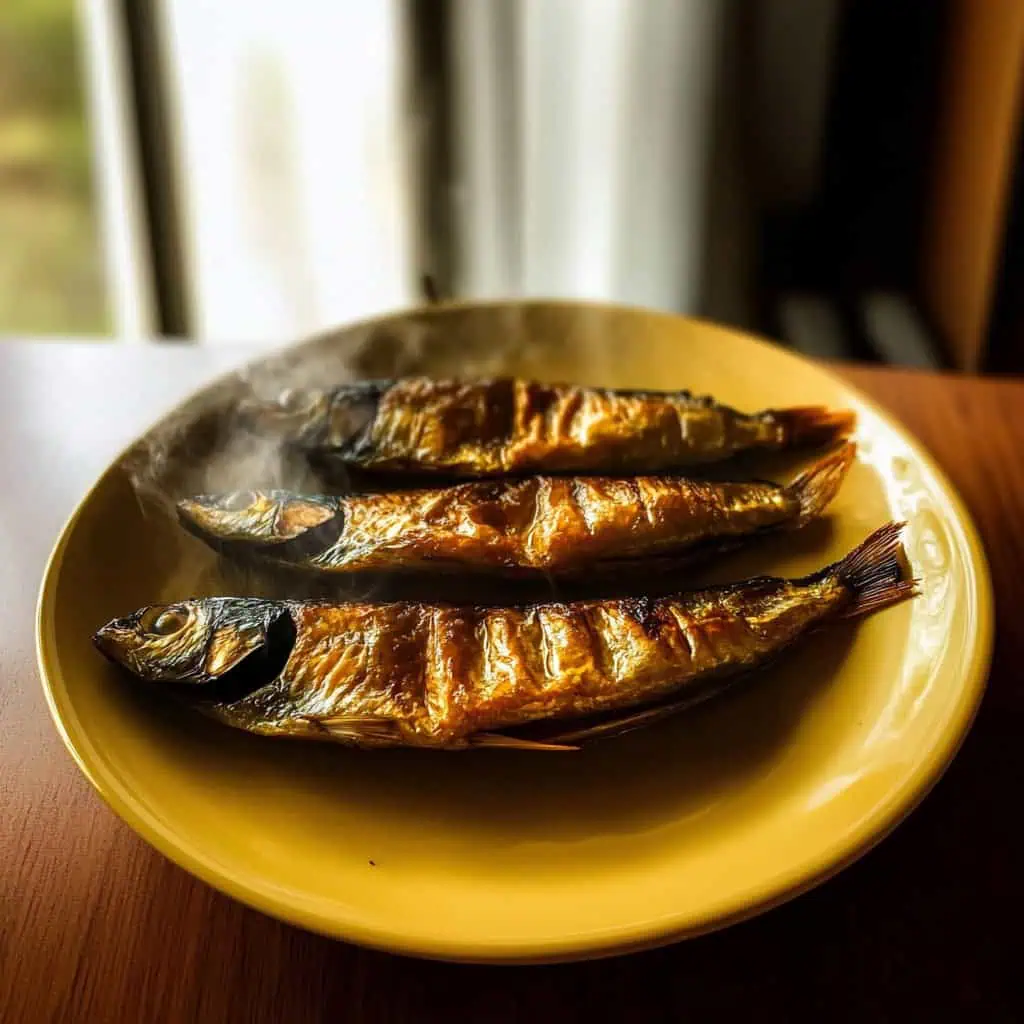









Comments
No Comments